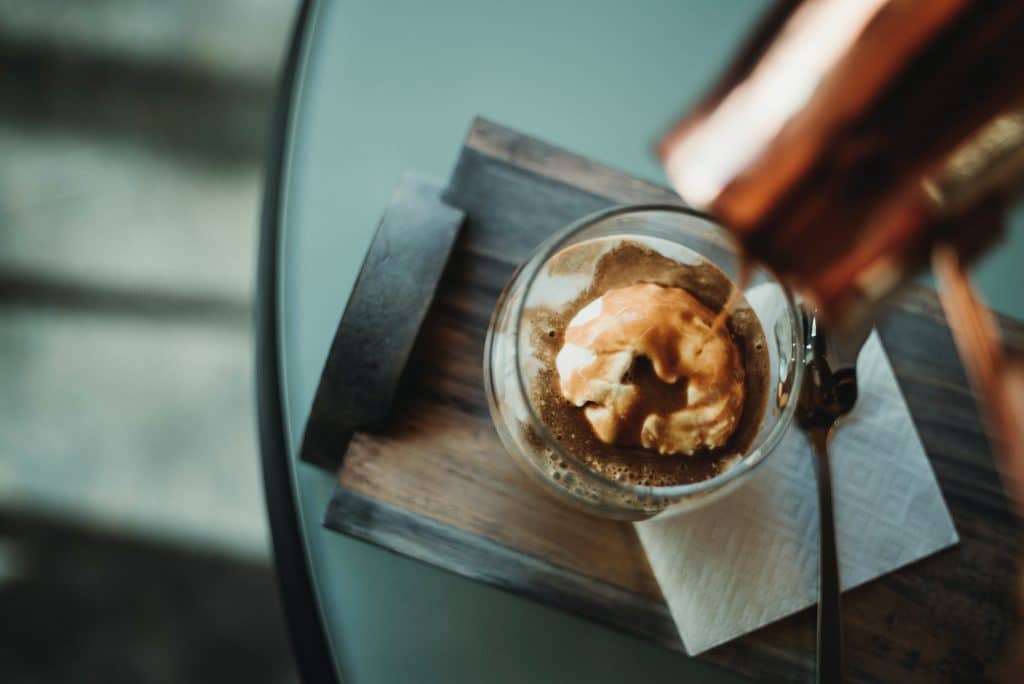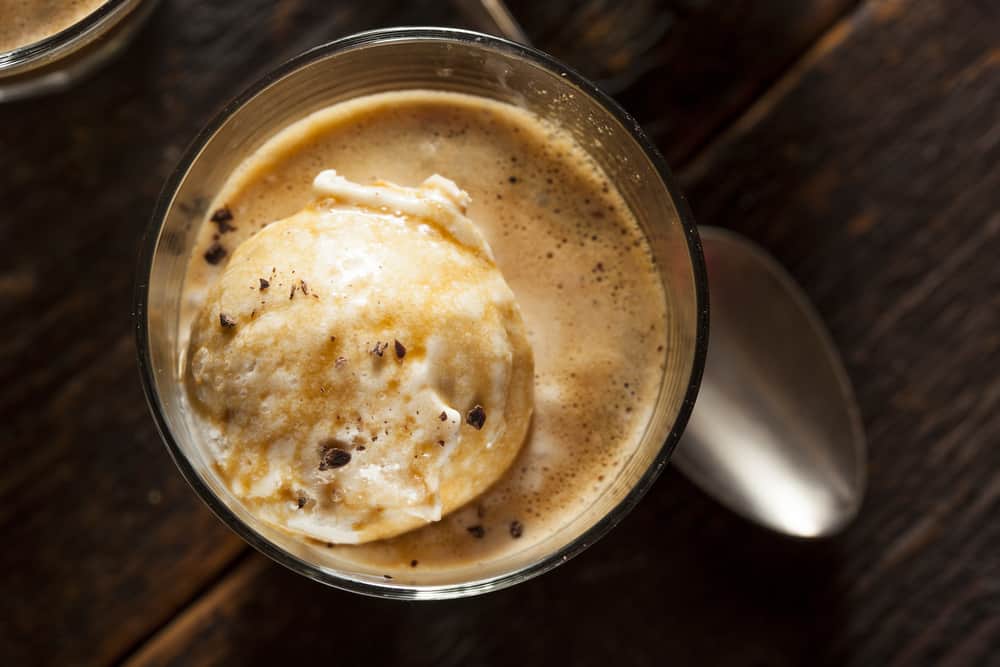Origins of Affogato

An affogato is a delightful Italian dessert where a scoop of ice cream or gelato is drowned in a steaming espresso shot, resulting in a delightful interplay of temperatures and flavors. Its name, affogato, is derived from the Italian word “affogare”, signifying the act of drowning, which aptly characterizes the dessert. Although the exact beginnings of Affogato remain uncertain, it is thought to have surfaced following the invention of the espresso machine.
History And Origins Of Affogato
While the deliciousness of affogato is widely acknowledged, its origin remains a subject of debate. There are a few theories and anecdotes about the origin of affogato, but it’s important to note that these stories are not necessarily supported by extensive historical records. Here are some of the theories:
- Invention In The 1950s: According to one theory, affogatos gained prominence in the 1950s in Italy, coinciding with the modernization of the ice cream industry. This theory suggests that the dessert’s popularity grew due to the availability of high-quality ice cream.
- Medieval Friar’s Creation: Another theory attributes the creation of affogato to a medieval friar named Angelico, who lived in the Piedmont region of Italy. According to this story, Friar Angelico spontaneously combined ice cream and espresso, creating an affogato.
- French Influence: Some believe that affogatos originated in Naples, Italy, but there are also claims that it has French origins or at least a French influence on its evolution. French culinary traditions have significantly impacted Italian cuisine over the centuries, and this influence is reflected in various Italian dishes, including affogatos. French sources suggest that affogatos were created in Naples and recommend experimenting with different ice cream flavors, such as pistachio and chocolate.
- Legend of Turin: Legend has it that the dish debuted in a quaint café in the northern Italian city of Turin. The café’s owner observed that patrons frequently ordered a shot of espresso alongside a serving of gelato or ice cream. One fateful day, he blended the two by pouring a steaming espresso over a scoop of gelato. The outcome was a delectable dessert rapidly gaining popularity among the café’s clientele, prompting other cafés across Italy to introduce their variations.
While affogatos have remained consistently popular in Europe, including Italy, their popularity has waned in the United States. This decline in interest, particularly in the U.S., can be attributed partly to the emergence of the Frappuccino in 1992, pioneered by George Howell. The Frappuccino was created as a fusion of soft ice cream and coffee, intended to pay homage to affogato but with a twist that made it reminiscent of a milkshake.
Re-emergence In The Modern Day
The resurgence of affogato can be attributed to the growth of specialty coffee shops and the creativity of modern gelato makers. These establishments have embraced the art of coffee-making and innovative preparations, offering affogato on their menus. This revival has attracted coffee enthusiasts who appreciate the fusion of robust coffee and luxurious ice cream or gelato.
Gelato artisans have elevated the traditional elements of affogato by experimenting with various flavors, introducing exciting variations like caramel, hazelnut, and coffee liqueur-infused gelato. The renewed popularity of affogato reflects the rediscovery of this timeless Italian dessert, celebrated for its harmonious blend of espresso’s bitterness and gelato’s creamy sweetness, making it a beloved indulgence.
Two Ingredient Affogato
Freshly Brewed Hot Espresso
Make sure your coffee beans are fresh. Use high-quality, freshly brewed hot espresso in your affogatos. It intensifies the coffee flavor, adds aromatic complexity, creates a temperature contrast, and provides a creamy crema layer. High-quality espresso balances the bitterness and sweetness, ensuring a consistent and delightful affogato experience.
Premium Fior di Latte Gelato Or Vanilla Ice Cream
Using premium Fior di Latte gelato in affogato improves its exceptional creaminess, pure milk flavor, and balanced sweetness. It complements the espresso, provides an authentic Italian experience, and enhances the dessert’s presentation, ensuring a delightful affogato every time. You can also use vanilla flavored ice cream or vanilla gelato as fior di latte may be difficult to find outside Italy. You can also use homemade ice cream to have quality control over your ice cream.
Classic Affogato Recipe

Creating affogato is a breeze, requiring only two ingredients and minimal preparation effort. If you enjoy ice cream and coffee, you are in for a treat.
Ingredients:
- 1 shot of hot espresso or strong hot coffee (approximately 1 ounce or 40 mL)
- 1 scoop of high-quality fior di latte gelato or ice cream (vanilla flavor is also a common substitute)
- Toppings and garnishes (Optional): Whipped cream, chocolate shavings, caramel sauce, nuts, biscotti, etc.
Instructions:
Step 1: Prepare to Brew A Shot Of Espresso
- Using an espresso machine or a stovetop espresso maker (Moka pot), prepare your coffee beans for brewing. Do not brew just yet.
Step 2: Scoop Ice Cream
- Place a scoop of high-quality creamy gelato or ice cream into a serving glass or a small dessert bowl.
Step 3: Brew Espresso Over Ice Cream
- Brew the espresso directly over the scoop of ice cream. The ice cream melts slightly upon contact with the hot espresso. Ensuring that it’s freshly brewed optimizes the flavors. You can also brew it into a separate cup and then pour it over, but I prefer less mess.
Step 4: Serve Immediately
- Affogato is best enjoyed immediately while the espresso is hot, creating a delightful contrast with the cold ice cream.
Step 5: Optional Garnishes
- You can garnish your affogato with toppings like chocolate shavings, crushed nuts (such as almonds or hazelnuts), whipped cream, or a drizzle of caramel or chocolate sauce for added flavor and visual appeal.
Step 6: Enjoy
- Use a spoon to scoop up a bit of both the espresso-soaked melted ice cream and the liquid espresso, savoring the harmonious blend of temperatures and flavors.
Your classic affogato can be enjoyed as a delightful dessert or afternoon pick-me-up. Feel free to customize it with your favorite toppings and variations as well.
Regional Adaptations Around The World
Affogatos have found their way to different parts of the world, each region putting its unique twist on this indulgent treat. Regional adaptations showcase variations in ingredients, flavors, and presentation, offering a delightful array of options for affogato lovers around the globe.
Different regions in Italy have added unique twists to the classic recipe. In Sicily, for example, affogatos are often enjoyed with a dash of coffee liqueur, while in northern Italy, it may be served with a concentrated coffee known as espresso ristretto. These regional variations speak to the diverse culinary landscape of Italy.
In North America, the traditional affogato recipe remains popular, combining a scoop of vanilla ice cream with a shot of hot espresso. However, inventive additions such as caramel sauce, coffee liqueur, or even a sprinkle of cocoa powder have become common.
In some Asian countries, affogato has taken a cultural twist by incorporating local flavors at the local coffee shop. Matcha, a powdered green tea, is often used as the base for the ice cream or gelato, complementing the espresso’s bitterness perfectly. Additionally, variations with tropical fruits, like mango or coconut, bring a refreshing twist to this beloved dessert.
From regional adaptations across the world, it is evident that affogato has become a versatile dessert, embracing local ingredients and flavors to create unique and exciting combinations. Whether it is a twist on the classic or a fusion of different culinary traditions, affogato continues to captivate taste buds with its adaptability and delightful flavors.
If you found the history of affogato interesting and informative, you may also appreciate these: History of Coffee and Origins of Cappuccino.
Alex is a web developer, writer, and marketer. He has degrees in English, Computer Science, and Mathematics and is always learning as much as he can. Alex operates a series of websites for both client and personal use. Alex usually starts the day with shot of espresso or an Americano and then follows up with a Cafe Au Lait with lunch. He enjoys trying new coffee beans and finding new ways to prepare it, but most days prefers to keep things simple.





